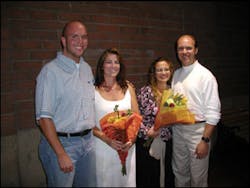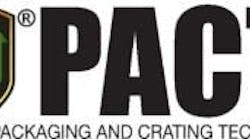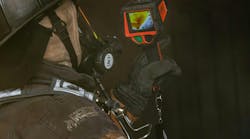In 1999, the Thorn Township Fire Department, in Thornville, OH (population 3,500), purchased a thermal imager (TI) with money donated largely from local fundraising. Last fall, firefighters used this TI to rescue 3-year-old Jonah West from his burning bedroom.
In a study published by the Federal Emergency management Agency (FEMA) in 2002, fire departments were asked if they owned at least one thermal imager. While the vast majority of the larger departments replied in the affirmative, most of the smaller departments didn’t expect to ever become equipped with a TI. Though Thornville, OH, falls into the category of “not likely to get a TI,” Jonah West is alive today because local officials and volunteers believed in the technology and did the legwork to raise money for the cause.
Among all of the products fire departments may purchase with fundraising dollars, thermal imagers are perhaps the most visual and compelling. When people have a hands-on experience with the technology, they can easily understand its benefits and the reasons why their firefighters need thermal imaging. This article offers planning tips for small communities raising funds for TIs.
Build your team. Don’t attempt to do everything yourself. Build a team, and assign responsibilities to team members. Use the individual skills of fire department members, their spouses and any interested community members to build the competency you need to run an effective campaign. At a minimum, you’ll need to fill the roles of campaign manager, campaign spokesperson, promotions/media relations manager, event manager and contribution manager. It may make sense in your department to have one person handle more than one of these roles.
Establish a plan. Major decisions about your campaign should be made at the first team meeting, with members receiving initial assignments before they leave. Use this meeting to identify your target audience(s), outline your message, determine your goal, establish your fundraising tactics and decide on the communications tools you will need to carry your message.
In small communities, your audiences could be the general public, civic organizations (such as the local Lions Club), businesses (in your response area as well as mutual aid areas) and local government. When considering how to communicate your message, first think about what will motivate your audiences to give. For example, if your department protects a rural area, discuss with potential donors that thermal imaging will not only greatly assist with structure fires, but the technology can also help you find children or ejected accident victims lost in fields or wooded areas. If your department is in a farming community, discuss the use of TIs in fighting silo fires. If you are appealing to a local business for support, talk to company leaders about how thermal imaging would assist in managing an incident at their facility.
Conduct a kickoff demonstration. It is likely that most members of your audience do not clearly understand the challenges you face on the job. Your campaign kickoff demonstration must enable potential donors to see for themselves what you do and how TIs can positively impact the work you perform. Communities around the country have been successful kicking off their campaigns by simulating search-and-rescue situations with non-toxic smoke and volunteer victims. Whether your demo is conducted in a training structure or in a dark room, plan the details carefully and invite as many people in your target audience as possible. Ideally, this event will give potential donors and media members the opportunity to experience the difficulty of searching in smoke versus the ease of searching with a TI.
Involve the local news media. Regardless of how you have decided to raise funds, the media can be a powerful ally in getting the word out about your campaign. Involve newspapers, radio stations, TV stations, newsletters and websites that cover news in your community. Be proactive. Before you kick off the campaign, ask a key local reporter to visit you and become familiar with thermal imaging and what you are attempting to achieve. A feature article published before your launch is a great way to get the public interested and involved in your effort.
To increase media coverage during your campaign, submit your own event pictures and captions to your local newspaper. This will get the word out even if media members can’t attend every event. Be sure to actively manage publicity for your largest donors by communicating their contributions through the media.
Fundraising appeals. With a well-oiled plan, your thermal imaging campaign should move along quickly. At any event you hold, try to include some type of technology demonstration, whether it is with an actual TI, a PowerPoint presentation or a video. Offer potential donors a simple handout that explains the benefits of thermal imaging in your community and requests their donation. Fundraising appeals should be diverse and frequent:
2. Set up booths at community events, to help the public understand what thermal imagers are and what they do.
3. Make presentations to local civic clubs and/or community centers that have funds for local projects.
4. Send a fundraising letter to the people you protect. If you have a local story you can share about how thermal imaging has made a difference (in a neighboring department, for example) or how it could have made a difference (the recent loss of a building in your community, for example) – share that story in your materials to bring your message home. Use photos to illustrate your points.
Conclusion
As your fire department initiates fundraising activities, remember not to limit yourselves to one funding source or to one funding approach. Build a team of dedicated people who are focused on the goal, and show potential donors how TIs work to save lives, preserve property and keep firefighters safe on the job.
With a determined, organized and passionate team, it’s within your reach to become equipped with thermal imagers, regardless of the size of your community.
Public Affairs Manager Rebecca Scholer directs thermal imaging funding programs for Bullard. In 2003, she developed and managed the introduction of the inSIGHT fundraising program, which helps firefighters and community leaders raise money locally for thermal imagers. Scholer also manages grant assistance programs offered by Bullard to fire departments seeking thermal imagers. She has a bachelor of science degree in journalism from Ball State University and an MBA from Indiana University. She may be contacted at [email protected].





